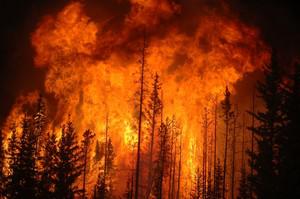WildfiresWildfires create much more pollution than previously thought
Naturally burning timber and brush launch what are called fine particles into the air at a rate three times as high as levels officially noted in emissions inventories at the U.S. Environmental Protection Agency, according to a new study. This does not mean that burning biomass produces more pollution than it previously did, but the new research makes clearer how much and what pollutants are inside a wildfire plume. Fine particles, the microscopic, sooty specks that form aerosols, are a hazard to human health, particularly to the lungs and heart.

Flame is not the only hazard from wildfires // Source: commons.wikimedia.org
Naturally burning timber and brush launch what are called fine particles into the air at a rate three times as high as levels officially noted in emissions inventories at the U.S. Environmental Protection Agency, according to a new study. This does not mean that burning biomass produces more pollution than it previously did, but the new research makes clearer how much and what pollutants are inside a wildfire plume.
Fine particles, the microscopic, sooty specks that form aerosols, are a hazard to human health, particularly to the lungs and heart.
“Burning biomass produces lots of pollution. These are really bad aerosols to breathe from a health point of view,” said researcher Greg Huey from the Georgia Institute of Technology, which led the study. The research also describes other chemicals in wildfire smoke, some never before measured, and it will likely raise the EPA estimated annual emission of fine particles, or particulate matter, in the western United States significantly.
The previous EPA data had been based on plume samples taken in controlled burns ignited by forestry professionals. Measuring naturally occurring plumes so thoroughly, from the sky, directly in the thick of a wildfire had not been possible before this study.
Plunging into plumes
Georgia Tech says that unique research missions deployed planes to plow through the plumes of three major wildfires, including the 2013 Rim Fire, the third-largest wildfire in California history. An ensemble of instruments bristling from the flanks of NASA and U.S. Department of Energy aircraft allowed teams of researchers on board to measure chemicals and particles in real time and cull masses of data, which the new study is based on.
“We actually went to measure, right above the fire, what was coming out,” said Huey, a professor in Georgia Tech’s School of Earth and Atmospheric Sciences, which he also chairs.
Bob Yokelson, a professor of atmospheric chemistry at the University of Montana has taken a leadership role in many aspects of the research and was in a group of about 20 scientists who selected the instruments to be installed on the large NASA plane. “We really didn’t have to go without anything we wanted really badly,” he said. Yokelson also helped design the flight paths.
